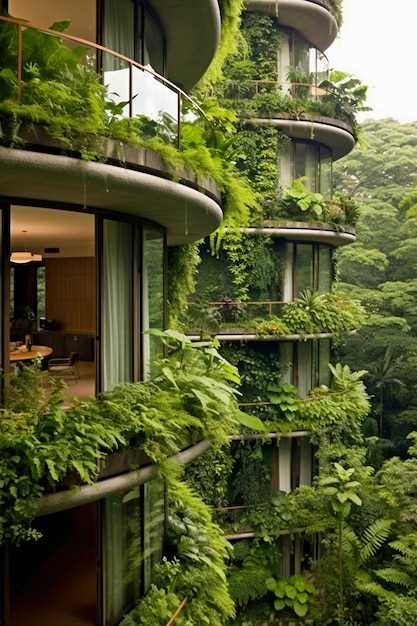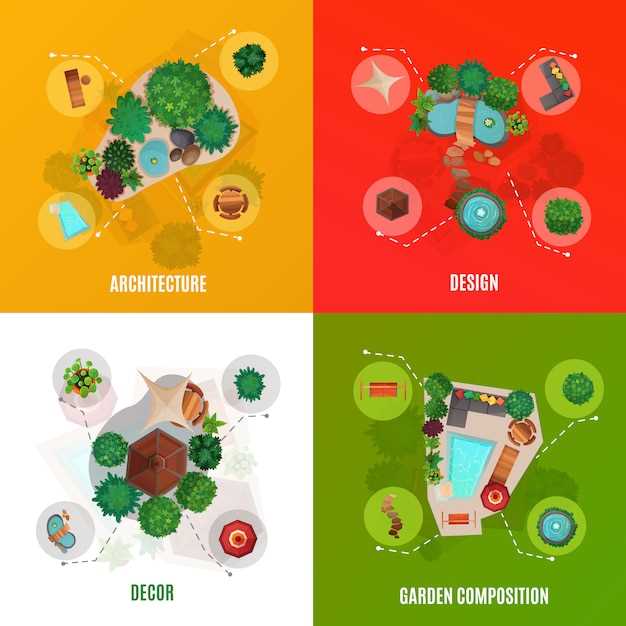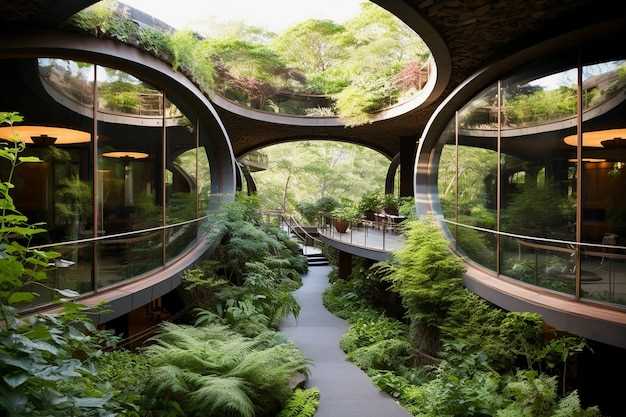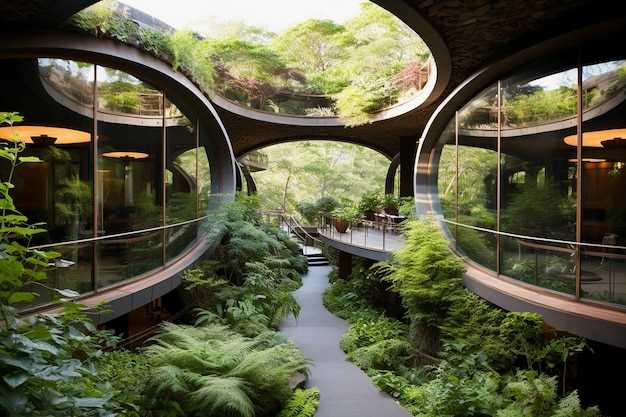The necessity for a harmonious relationship between our dwellings and nature has never been more pressing. As we face the challenges of climate change and resource depletion, the movement toward more mindful construction methods gains momentum. This shift is not merely about aesthetics or functionality but speaks to a fundamental need for sustainability. How can we create a balance between modern living and environmental stewardship?
Understanding the core aspects of responsible architecture is essential. It involves materials, energy efficiency, and the overall impact on our planet. Every decision counts; from the type of insulation used to the energy sources powering our homes. A carefully curated environment can reduce waste, limit energy consumption, and foster a deeper connection to the surrounding ecosystem.
Technical innovations play a critical role in facilitating this transformation. Renewable energy solutions, water conservation techniques, and smart technologies allow occupants to minimize their carbon footprint. However, the key lies in integrating these solutions seamlessly into everyday life, so that sustainability becomes second nature. Long-term benefits arise when we think beyond mere compliance and strive for excellence in every aspect of our living spaces.
In the end, the journey toward creating a more conscious habitat is a collaborative effort. It invites architects, builders, and homeowners to join forces in shaping environments that thrive harmoniously with nature. The vision is one of beauty, efficiency, and responsibility, encouraging not just survival, but flourishing. The future of living is at our fingertips, awaiting the embrace of thoughtful transformation.
Eco Design Principles for Sustainable Homes

Creating living environments that respect and nurture our planet is essential. Innovative approaches can lead to a significant change in how we inhabit spaces. By making conscious choices, we can minimize our impact on the environment. Whether through materials, energy consumption, or water usage, every decision matters.
It starts with understanding the local climate and environment. Using natural elements fosters harmony between the structures we build and the world around us. The integration of renewable energy sources plays a vital role. Devices harnessing solar power assist in reducing reliance on non-renewable resources.
Materials are fundamental to this endeavor. Choosing locally sourced, sustainable resources can drastically cut transportation emissions. Additionally, opting for recycled or reclaimed materials reduces waste. It’s about creating a cycle of sustainability.
Furthermore, efficient water management is crucial. Implementing rainwater harvesting systems can alleviate pressure on local water supplies. The strategic placement of plants enhances biodiversity while also providing natural insulation. When these aspects are combined, they create a resilient habitat.
Incorporating passive design strategies can naturally regulate indoor temperatures. Proper shading and ventilation systems enhance comfort without excessive energy use. Smart technology can also streamline energy consumption, making our lives easier and more efficient. Ultimately, it’s about aligning our living spaces with ecological balance.
All these elements work together to promote a healthier lifestyle. Communities benefiting from such thoughtful approaches experience richer connections with nature. It’s not merely about a structure; it’s about a philosophy that transforms our everyday existence.
Creating Healthy Living Spaces

Crafting environments that foster well-being is essential for modern lifestyles. A balanced atmosphere promotes physical and mental health. Thoughtful choices can enhance our quality of life. It’s not just about aesthetics; it’s about creating a sanctuary.
When considering interior setups, let’s focus on a few key elements:
- Natural light
- Air quality
- Use of non-toxic materials
- Incorporation of greenery
Natural light is crucial. It elevates mood and boosts energy levels. Fresh air circulation can significantly reduce harmful pollutants. Moreover, using safe and non-toxic materials ensures the health of occupants.
Additionally, indoor plants play an instrumental role. They purify the air and create a calm atmosphere. Imagine a room where peace reigns, illuminated by sunlight streaming through wide windows, alive with vibrant plants that refresh the air and soothe the spirit.
Sound management also matters. Acoustic elements influence relaxation. Keeping external noise at bay can vastly improve comfort. Choose materials wisely to absorb sound while maintaining an inviting appearance.
Incorporating wellness-focused practices contributes positively. Mindful layouts can encourage movement and interaction. Ensuring ample open spaces fosters connection. Avoid clutter; invest in organization to promote tranquility.
Embracing these concepts is a journey toward health-promoting environments. Each step matters in crafting a setting that supports well-being.
Understanding Biophilic Design
Embracing nature within our living spaces brings a sense of tranquility. It enhances our connection to the environment surrounding us. This concept emphasizes integrating natural elements into our interiors and structures. It’s about creating harmony between built environments and the natural world. The result is a refreshing atmosphere that fosters well-being.
Imagine walking into a room filled with sunlight and greenery. Each detail matters. The sounds of water trickling, the scent of fresh flowers, and the sight of vibrant plants can transform any area. This approach stimulates not only our senses but also our minds. It invites a deeper appreciation of nature’s beauty.
Incorporating these elements can lead to increased productivity and a more positive mindset. When nature is present, stress levels drop significantly. Studies suggest that people surrounded by natural forms report higher satisfaction and happiness. By using natural materials, maximizing daylight, and including outdoor views, we bridge the gap between indoor and outdoor experiences.
This strategy fosters a holistic environment that prioritizes human comfort. It encourages creativity, providing inspiration through visual diversity. Furthermore, integrating biophilic aspects supports biodiversity and promotes a healthier ecosystem within urban settings. As we become more aware of our surroundings, we find better ways to live harmoniously with nature.
Utilizing Natural Light and Ventilation
Harnessing the power of sunlight and fresh air can profoundly impact any living space. Well-placed openings allow daylight to flow in, creating an uplifting ambiance. This strategy not only enhances the aesthetic appeal but also promotes well-being. Many overlook the benefits of proper airflow. Yet, it plays a crucial role in comfort and energy efficiency.
Maximizing sunlight can lead to significant savings on artificial lighting costs. Large windows, skylights, and thoughtful architectural features invite brightness indoors. Furthermore, this approach reduces the reliance on electricity, contributing to a lower environmental footprint. When combined with smart ventilation methods, the results become even more impressive.
Fresh air circulation is essential for maintaining quality indoor environments. Properly positioned windows and vents allow for cross-ventilation, efficiently regulating temperature throughout the year. Natural airflow can cool spaces in warmer months and promote warmth during colder periods. Strategically designing these openings ensures that residents feel comfortable without excessive energy consumption.
Integrating these elements into a living area leads to holistic harmony. Emphasizing light and airflow results in joyful, vibrant spaces. In the long run, an approach prioritizing these aspects cultivates a truly inviting atmosphere while benefiting both inhabitants and the planet alike. A balanced combination of sunlight and ventilation not only elevates a space’s livability but also aligns with a thoughtful lifestyle choice.
Choosing Non-Toxic Materials
Ensuring a healthy environment within our living spaces starts with material selection. It’s crucial to opt for substances that do not emit harmful chemicals. The impact on both physical wellness and the planet can be substantial. More mindful choices lead to safer homes for everyone.
- Natural fibers like wool and cotton offer better indoor air quality.
- Wood should be sourced from sustainable forests with no harmful treatments.
- Paints and finishes that are low in volatile organic compounds (VOCs) help reduce toxicity.
- Recycled materials often have a smaller ecological footprint.
When considering building or renovating living quarters, it’s essential to prioritize products that elevate health and minimize environmental harm, as this practice not only contributes to individual well-being but also fosters a positive ecosystem for future generations.
- Research suppliers that specialize in non-toxic selections.
- Look for certifications that indicate safety and sustainability.
- Implement local resources to reduce transportation emissions.
- Involve your family in the selection process for educational purposes.
Incorporating non-toxic options into your daily life can feel daunting, yet the benefits far outweigh the challenges, ensuring that your abode becomes a sanctuary free from harmful pollutants while supporting the health of our broader environment.
Strategies for Environmental Impact Reduction

Reducing the negative effects on our environment is critical. Every small action counts. Individuals and communities can take significant steps. Our collective choices shape the world around us. Understanding how to alleviate harm is essential.
Using renewable energy sources is one key approach. Solar panels harness sunlight, while wind turbines capture breeze. By embracing these technologies, reliance on fossil fuels diminishes. This transition plays a crucial role in lowering carbon emissions and promoting cleaner air.
Water conservation methods are also vital. Simple measures such as rainwater harvesting can provide irrigation for gardens. Employing low-flow fixtures decreases overall water usage dramatically. By making these adjustments, households can contribute to significant resource preservation.
Implementing efficient waste management systems is another important element. Proper recycling and composting reduce landfill contributions, enhancing soil health. However, educating residents about waste segregation greatly increases effectiveness. When communities actively engage in these practices, a positive ripple effect occurs.
Choosing sustainable materials leads to long-lasting benefits. Sourcing local ingredients reduces transportation emissions while supporting the economy. Biodegradable options diminish landfill waste and enhance environmental health. Thus, informed decisions can transform everyday living into mindful practices that respect our planet.
Lastly, creating green spaces enhances biodiversity. Urban areas benefit from parks and gardens, providing habitats for wildlife. These natural environments not only improve air quality but also promote mental well-being. As more cities focus on incorporating nature, we foster a more balanced coexistence.
Incorporating Renewable Energy Sources
Utilizing natural energy alternatives plays a pivotal role in modern living. This approach not only reduces the environmental impact but also enhances energy independence. With various options available, homeowners can select systems that best fit their needs. From sunlight to wind, harnessing these resources opens a world of possibilities. Imagine a house fully powered by nature’s gifts.
Solar panels transform sunlight into electricity, making it a popular choice. Wind turbines capture wind power, generating energy even in remote areas. Geothermal systems use the earth’s heat for efficient heating and cooling. These technologies provide not just sustainability but also long-term savings. Integrating such solutions creates a resilient infrastructure.
Moreover, incorporating these sources requires thoughtful planning. Each energy system has unique requirements and benefits. It is essential to assess the local climate and geographical features. Homeowners should also consider energy consumption patterns over time. Combining multiple sources can further enhance efficiency and reliability.
Incorporating renewable sources can yield significant environmental and economic advantages. From decreasing utility bills to minimizing carbon footprints, the benefits abound. Families can enjoy greater energy security while contributing to a healthier ecosystem. Exploring available incentives can facilitate the transition to greener energy options. A proactive stance today sets the stage for future generations.
Optimizing Water Efficiency
Water management is essential in creating a harmonious living environment. Every drop counts, and making the most of this vital resource can lead to significant benefits. Embracing strategies that reduce consumption is crucial. Effective practices not only conserve water but also promote a healthier ecosystem. We must rethink conventional usage to foster a mindful approach.
Rainwater harvesting systems can channel precipitation efficiently. Greywater recycling offers another innovative solution. Utilizing these systems reduces reliance on traditional supply. Moreover, they encourage a deeper appreciation for the natural cycles around us. This holistic approach can transform how we perceive and use water in our everyday lives.
Low-flow fixtures and smart irrigation contribute significantly to conservation efforts. Such installations minimize waste while maintaining comfort and functionality. Drought-resistant landscaping can further support sustainable objectives. These practices might seem simple but yield profound changes. By optimizing our water consumption, we can create resilient communities.
Integrated technology often plays a pivotal role in efficient resource management. Smart meters provide real-time usage data. This empowers homeowners to track consumption patterns and adjust accordingly. Consequently, mindful decision-making becomes second nature. Also, education and awareness can inspire collective action towards responsible water use.
Ultimately, enhancing water efficiency requires a proactive mindset and innovative solutions. It calls for collaboration and commitment from individuals and communities alike. Small changes can accumulate and lead to a significant impact over time. By embracing efficiency, we contribute to a healthier planet and a more sustainable lifestyle.
Implementing Waste Reduction Practices
Minimizing waste is essential in our approach to creating functional living areas. Every small action counts. It’s about being mindful of what we consume and how we handle materials. By adopting effective strategies, we can significantly reduce unnecessary waste in our daily activities.
First and foremost, understanding the types of waste generated is crucial. Common household items often end up in landfills when they could be reused or repurposed. Implementing recycling programs encourages proper disposal and allows resources to be reintegrated into the cycle of production. Additionally, donating unwanted items extends their lifespan, benefiting both the environment and the community.
Another effective method involves embracing local resources. Sourcing materials from nearby suppliers not only lowers transportation emissions but also supports local economies. This conscious effort can lead to a stronger connection with the community and a decreased ecological footprint. Furthermore, choosing products with minimal packaging can dramatically cut down on waste generated from single-use materials.
Moreover, composting organic waste transforms a significant portion of rubbish into valuable fertilizer. This practice fosters healthier soil while simultaneously diverting waste from landfills. It’s a simple yet powerful means to enrich the environment around us with nutrients. Over time, such practices empower individuals to become stewards of their surroundings, inspiring others to do the same.
Implementing these strategies requires commitment but brings long-lasting benefits. Each step taken toward waste reduction contributes to a collective effort. Efficiency in managing resources creates a ripple effect, influencing households and communities alike. The goal is not merely to minimize disposal but to cultivate a mindset that values sustainability and prioritizes responsible consumption.
Assessing Lifecycle Impact of Materials
Understanding the influence of materials over their entire existence is crucial. Each choice can significantly affect our environment. From extraction to disposal, the path of materials shapes ecological consequences. Evaluating this process allows us to make informed decisions. It’s about more than just what looks good.
To accurately gauge impacts, one must consider various factors. The energy consumed in production, as well as transportation methods, plays a vital role. Additionally, assessing how materials behave during their lifespan is essential. Do they off-gas harmful chemicals? Or can they be recycled easily? These questions guide responsible choices.
The table below summarizes key factors influencing material impact:
| Factor | Description |
|---|---|
| Energy Use | Amount of energy needed in production and transportation. |
| Resource Extraction | Impact of removing natural resources from the environment. |
| Durability | How well a material holds up over time. |
| Toxicity | Potential health hazards associated with materials. |
| Recyclability | Ease of reusing materials at the end of their life. |
By assessing these elements comprehensively, we can better understand the true costs associated with material choices. In this way, our selections can reflect a commitment to reducing adverse effects, fostering healthier environments, and promoting longevity in every project undertaken. Embracing this approach leads to tangible progress toward a more responsible lifestyle.
Video:
Exploring Green Building and the Future of Construction
Exploring Green Building and the Future of Construction by Undecided with Matt Ferrell 560,520 views 3 years ago 13 minutes, 33 seconds
Q&A:
What are the fundamental principles of eco design for sustainable homes?
Eco design for sustainable homes is centered around several key principles aimed at minimizing environmental impact while maximizing efficiency. Firstly, effective site selection is crucial; this involves analyzing the landscape to optimize natural light, reduce energy consumption, and promote biodiversity. Secondly, materials sourcing focuses on using renewable, recycled, or locally sourced materials to reduce transportation emissions and support local economies. Thirdly, energy efficiency is prioritized through smart layout and design, materials that provide insulation, and the integration of renewable energy sources like solar panels. Lastly, water conservation measures, such as rainwater harvesting and low-flow fixtures, are essential for reducing water usage and promoting sustainability. By following these principles, homeowners can create spaces that are not only functional but also environmentally friendly.
How can eco design principles be integrated into existing homes?
Integrating eco design principles into existing homes is both feasible and impactful. Homeowners can start with simple measures such as improving insulation, which can significantly reduce energy costs and increase comfort. Upgrading windows to energy-efficient models can also enhance thermal performance. Additionally, installing programmable thermostats and energy-efficient lighting systems will lower energy consumption. On the water conservation front, homeowners can replace traditional fixtures with low-flow options and consider rainwater collection systems. For landscaping, switching to native plants can promote biodiversity and reduce water usage. Making these incremental changes not only improves sustainability but can also enhance the overall value and enjoyment of the home.
What are some sustainable materials that can be used in eco design?
When choosing materials for eco design, it’s important to consider sustainability and environmental impact. Some excellent options include bamboo, which is a rapidly renewable resource known for its strength and versatility. Reclaimed wood can also add character to a home while preventing deforestation and reducing waste. Additionally, recycled steel is a durable choice for structural components, as it contributes to reducing the demand for new materials. Green insulation materials, such as cellulose made from recycled paper or sheep’s wool, provide excellent thermal performance with a smaller environmental footprint. Lastly, using low-VOC (volatile organic compounds) paints and finishes improves indoor air quality while minimizing harmful emissions. By selecting these materials, homeowners can significantly lower their ecological impact while creating beautiful and functional spaces.
What are the benefits of eco-designed homes for homeowners?
Eco-designed homes offer numerous benefits to homeowners, both in terms of environmental impact and personal well-being. Firstly, these homes typically have lower utility bills due to improved energy efficiency, which translates into significant cost savings over time. Secondly, eco homes are often designed to provide better indoor air quality by using non-toxic materials and adequate ventilation systems, contributing to healthier living conditions. Additionally, eco-designed homes can increase property value, as sustainability becomes a more desirable selling point in the real estate market. Finally, living in a sustainable home can enhance the homeowner’s sense of well-being and connection to nature, as these designs often maximize natural light and outdoor views, creating a more pleasant living environment.
Can eco design principles be applied to urban environments as well as rural ones?
Absolutely! Eco design principles are highly adaptable and can be applied in both urban and rural settings. In urban environments, the emphasis may be placed on maximizing space efficiency and integrating greenery, such as rooftop gardens or vertical gardens, which help mitigate the urban heat island effect while promoting biodiversity. Urban homes can also focus on reducing transportation emissions by being located near public transport and essential services. In contrast, rural eco design might leverage natural resources and promote sustainable agricultural practices, such as permaculture. Both settings can benefit from energy-efficient practices and the use of sustainable materials. Ultimately, eco design encourages thoughtful planning and connection to the surrounding environment, regardless of location.
What are the key eco design principles that can be applied to create sustainable homes?
Eco design principles focus on minimizing environmental impact while maximizing efficiency and comfort. Key principles include: 1) Energy efficiency: Utilizing insulation, efficient heating and cooling systems, and renewable energy sources like solar panels. 2) Sustainable materials: Choosing locally sourced, recycled, or rapidly renewable materials, such as bamboo or reclaimed wood. 3) Water conservation: Incorporating systems like rainwater harvesting, greywater recycling, and low-flow fixtures to reduce water usage. 4) Indoor environmental quality: Ensuring good air quality through proper ventilation, non-toxic materials, and natural lighting. 5) Flexibility and adaptability: Designing spaces that can be easily modified according to changing needs, which can prolong the lifespan of the structure. Overall, these principles help in transforming spaces into sustainable homes that contribute to a greener future, promoting health and well-being for both residents and the environment.
